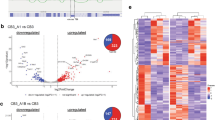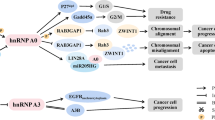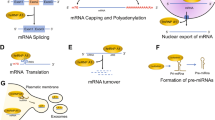Abstract
The oncoprotein SET participates in a diversity of cellular functions including cell proliferation. Its role on cell cycle progression is likely mediated by inhibiting cyclin B-cdk1 and the protein phosphatase 2A (PP2A). On identifying new SET cellular partners, we found that SET interacts in vitro and in vivo with the heterogeneous nuclear ribonucleoprotein A2 (hnRNPA2); a protein involved in various aspects of mRNA biogenesis. The SET-binding region of hnRNPA2 is the RNP1 sequence that belongs to the RNA-binding domain (RBD) of this protein. We also found that hnRNPA2 has much higher affinity for single-standed DNA than for SET. On analysing the effect of hnRNPA2 on PP2A inhibition by SET, we observed that hnRNPA2 cooperates with SET on PP2A inhibition. This is because we found that hnRNPA2 is also a PP2A inhibitor. HnRNPA2 interacts with PP2A by the RNP1 sequence; however, to inhibit PP2A activity, the complete RBD is needed. We also observed that overexpression of hnRNPA2 inhibits PP2A activity and stimulates cell proliferation. Interestingly, the overexpression of the complete RBD is sufficient to stimulate proliferation. As hnRNPA2 is overexpressed in a variety of human tumors, our results suggest that hnRNPA2 might participate in oncogenesis by stimulating cell proliferation.
This is a preview of subscription content, access via your institution
Access options
Subscribe to this journal
Receive 50 print issues and online access
$259.00 per year
only $5.18 per issue
Buy this article
- Purchase on SpringerLink
- Instant access to full article PDF
Prices may be subject to local taxes which are calculated during checkout








Similar content being viewed by others
References
Adler HT, Nallaseth FS, Walter G, Tkachuk DC . (1997). J Biol Chem 272: 28407–28414.
Ainger K, Avossa D, Diana AS, Barry C, Barbarese E, Carson JH . (1997). J Cell Biol 138: 1077–1087.
Beresford PJ, Zhang D, Oh DY, Fan Z, Greer EL, Russo ML et al. (2001). J Biol Chem 276: 43285–43293.
Bosser R, Faura M, Serratosa J, Renau-Piqueras J, Pruschy M, Bachs O . (1995). Mol Cell Biol 15: 661–670.
Canela N, Rodriguez-Vilarrupla A, Estanyol JM, Diaz C, Pujol MJ, Agell N et al. (2003). J Biol Chem 278: 1158–1164.
Chen W, Possemato R, Campbell KT, Plattner CA, Pallas DC, Hahn WC . (2004). Cancer Cell 5: 127–136.
Chou DM, Petersen P, Walter JC, Walter G . (2002). J Biol Chem 277: 40520–40527.
Clarke PR, Hoffmann I, Draetta G, Karsenti E . (1993). Mol Biol Cell 4: 397–411.
Dreyfuss G, Kim VN, Kataoka N . (2002). Nat Rev Mol Cell Biol 3: 195–205.
Elder RT, Yu M, Chen M, Zhu X, Yanagida M, Zhao Y . (2001). Virology 287: 359–370.
Estanyol JM, Jaumot M, Casanovas O, Rodriguez-Vilarrupla A, Agell N, Bachs O . (1999). J Biol Chem 274: 33161–33165.
Fan Z, Beresford PJ, Oh DY, Zhang D, Lieberman J . (2003a). Cell 112: 659–672.
Fan Z, Beresford PJ, Zhang D, Lieberman J . (2002). Mol Cell Biol 22: 2810–2820.
Fan Z, Beresford PJ, Zhang D, Xu Z, Novina CD, Yoshida A et al. (2003b). Nat Immunol 4: 145–153.
Fielding P, Turnbull L, Prime W, Walshaw M, Field JK . (1999). Clin Cancer Res 5: 4048–4052.
Ford LP, Wright WE, Shay JW . (2002). Oncogene 21: 580–583.
Janssens V, Goris J . (2001). Biochem J 353: 417–439.
Kellogg DR, Kikuchi A, Fujii-Nakata T, Turck CW, Murray AW . (1995). J Cell Biol 130: 661–673.
Kinoshita N, Yamano H, Niwa H, Yoshida T, Yanagida M . (1993). Genes Dev 7: 1059–1071.
Krecic AM, Swanson MS . (1999). Curr Opin Cell Biol 11: 363–371.
Kutney SN, Hong R, Macfarlan T, Chakravarti D . (2004). J Biol Chem 279: 30850–30855.
Kwon S, Barbarese E, Carson JH . (1999). J Cell Biol 147: 247–256.
Li M, Makkinje A, Damuni Z . (1996a). Biochemistry 35: 6998–7002.
Li M, Makkinje A, Damuni Z . (1996b). J Biol Chem 271: 11059–11062.
Lieberman J, Fan Z . (2003). Curr Opin Immunol 15: 553–559.
Matsumoto K, Nagata K, Ui M, Hanaoka F . (1993). J Biol Chem 268: 10582–10587.
Millward TA, Zolnierowicz S, Hemmings BA . (1999). Trends Biochem Sci 24: 186–191.
Moran-Jones K, Wayman L, Kennedy DD, Reddel RR, Sara S, Snee MJ et al. (2005). Nucleic Acids Res 33: 486–496.
Mulshine JL, De Luca LM, Dedrick RL, Tockman MS, Webster R, Placke ME . (2000). Cancer 89: 2465–2467.
Okuwaki M, Nagata K . (1998). J Biol Chem 273: 34511–34518.
Pandey AV, Mellon SH, Miller WL . (2003). J Biol Chem 278: 2837–2844.
Patry C, Bouchard L, Labrecque P, Gendron D, Lemieux B, Toutant J et al. (2003). Cancer Res 63: 7679–7688.
Qu D, Li Q, Lim HY, Cheung NS, Li R, Wang JH et al. (2002). J Biol Chem 277: 7324–7332.
Sanchez-Piris M, Posas F, Alemany V, Winge I, Hidalgo E, Bachs O et al. (2002). J Biol Chem 277: 17722–17727.
Schonthal A, Feramisco JR . (1993). Oncogene 8: 433–441.
Schonthal AH . (2001). Cancer Lett 170: 1–13.
Seo SB, McNamara P, Heo S, Turner A, Lane WS, Chakravarti D . (2001). Cell 104: 119–130.
Shikama N, Chan HM, Krstic-Demonacos M, Smith L, Lee CW, Cairns W et al. (2000). Mol Cell Biol 20: 8933–8943.
Tockman MS, Mulshine JL, Piantadosi S, Erozan YS, Gupta PK, Ruckdeschel JC et al. (1997). Clin Cancer Res 3: 2237–2246.
Van Hoof C, Goris J . (2004). Cancer Cell 5: 105–106.
von Lindern M, van Baal S, Wiegant J, Raap A, Hagemeijer A, Grosveld G . (1992). Mol Cell Biol 12: 3346–3355.
Yan Y, Mumby MC . (1999). J Biol Chem 274: 31917–31924.
Yan-Sanders Y, Hammons GJ, Lyn-Cook BD . (2002). Cancer Lett 183: 215–220.
Zhou J, Allred DC, Avis I, Martinez A, Vos MD, Smith L et al. (2001). Breast Cancer Res Treat 66: 217–224.
Acknowledgements
This work was supported by Grants SAF 2002-00452, SAF 2003-08339 and GEN 2003-2043-C08-01 from the Ministerio de Educación y Ciencia, Spain. Financial support was also obtained from the Red temática del Cáncer, Instituto Carlos III, No. C03/10. Proteomic analysis was performed at the Proteomic Unit of the ‘Serveis cientifico-tècnics’ from the University of Barcelona.
Author information
Authors and Affiliations
Corresponding author
Rights and permissions
About this article
Cite this article
Vera, J., Jaumot, M., Estanyol, J. et al. Heterogeneous nuclear ribonucleoprotein A2 is a SET-binding protein and a PP2A inhibitor. Oncogene 25, 260–270 (2006). https://doi.org/10.1038/sj.onc.1209050
Received:
Revised:
Accepted:
Published:
Issue date:
DOI: https://doi.org/10.1038/sj.onc.1209050
Keywords
This article is cited by
-
Galectin-3 interacts with components of the nuclear ribonucleoprotein complex
BMC Cancer (2016)
-
Impact of Obesity and Leptin on Protein Expression Profiles in Mouse Colon
Digestive Diseases and Sciences (2011)
-
TSPY and its X-encoded homologue interact with cyclin B but exert contrasting functions on cyclin-dependent kinase 1 activities
Oncogene (2008)
-
ReSETting PP2A tumour suppressor activity in blast crisis and imatinib-resistant chronic myelogenous leukaemia
British Journal of Cancer (2006)



